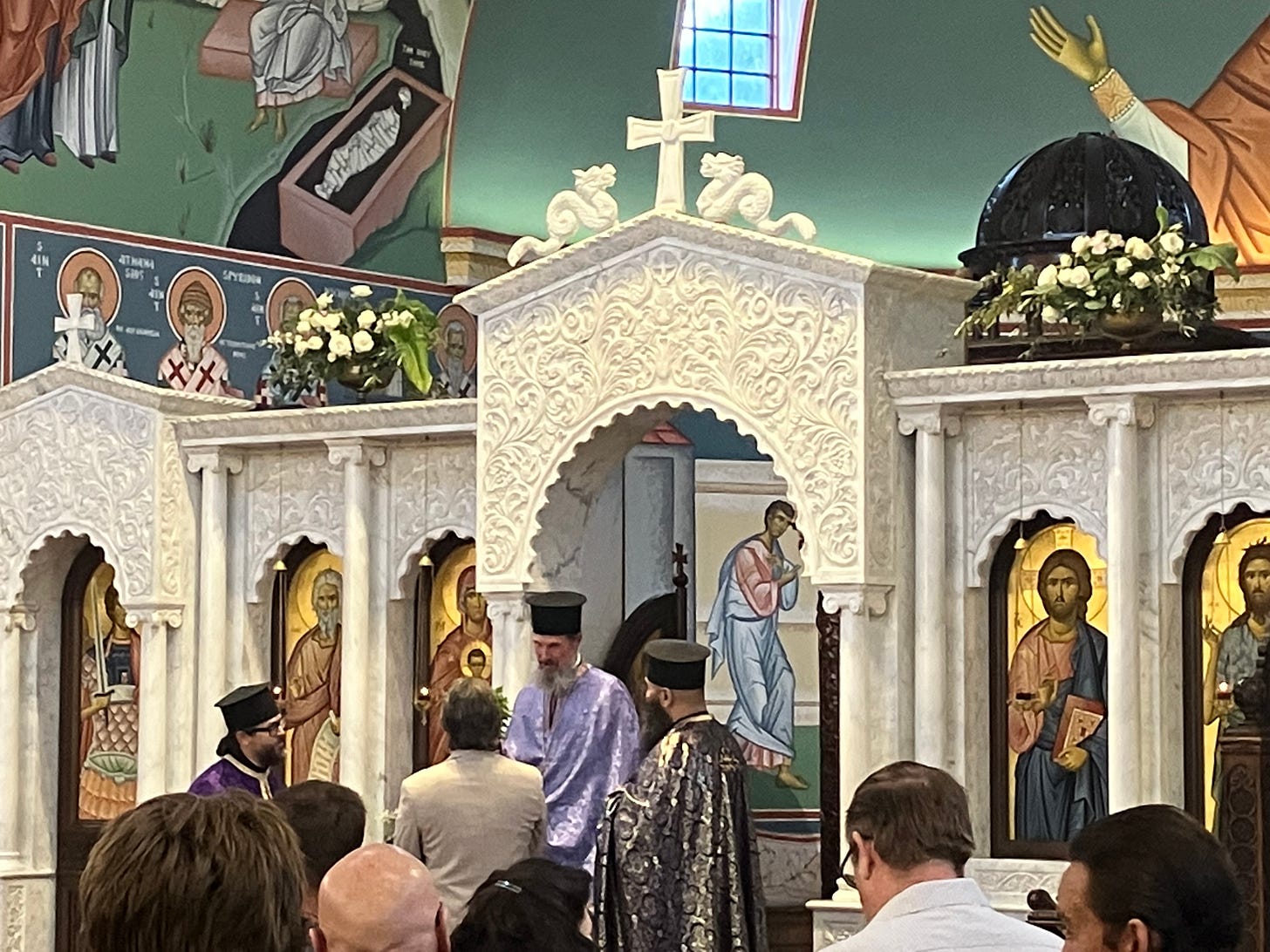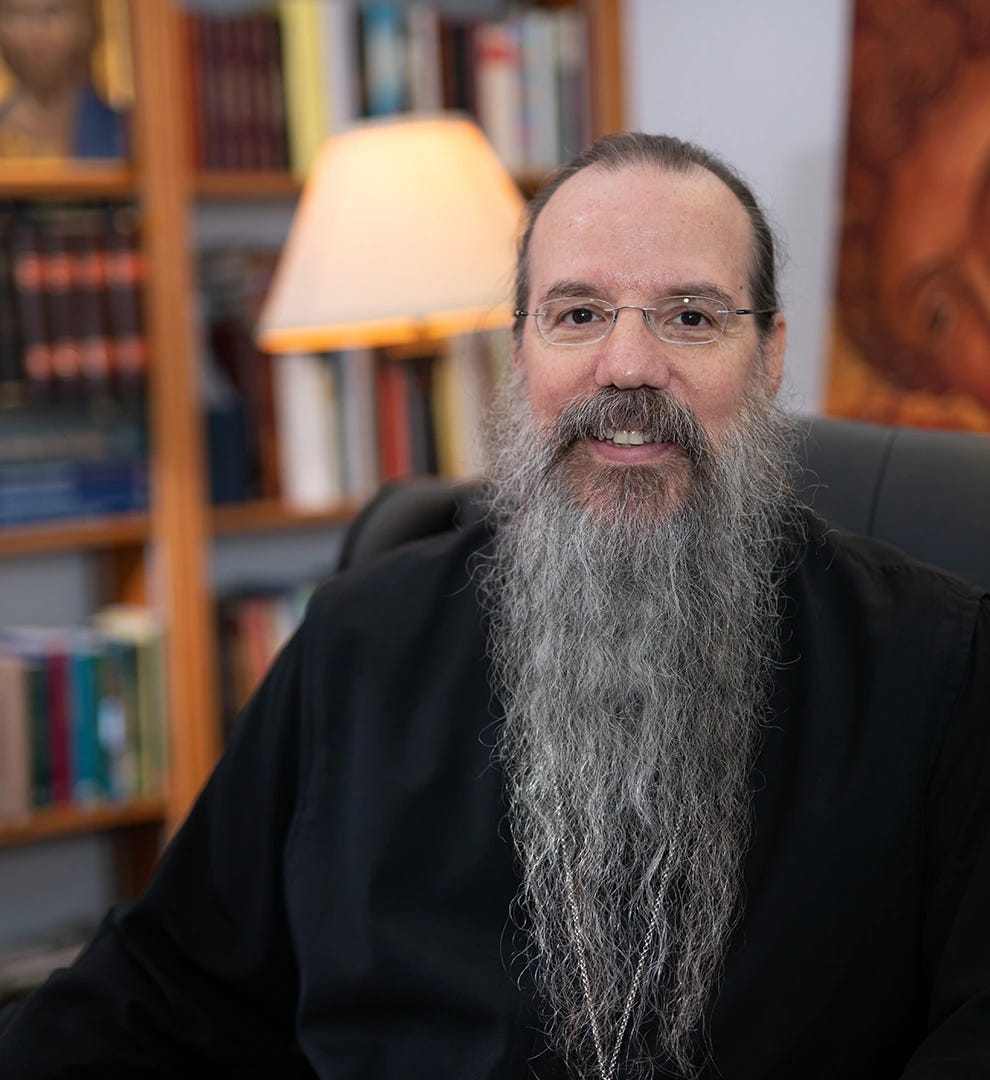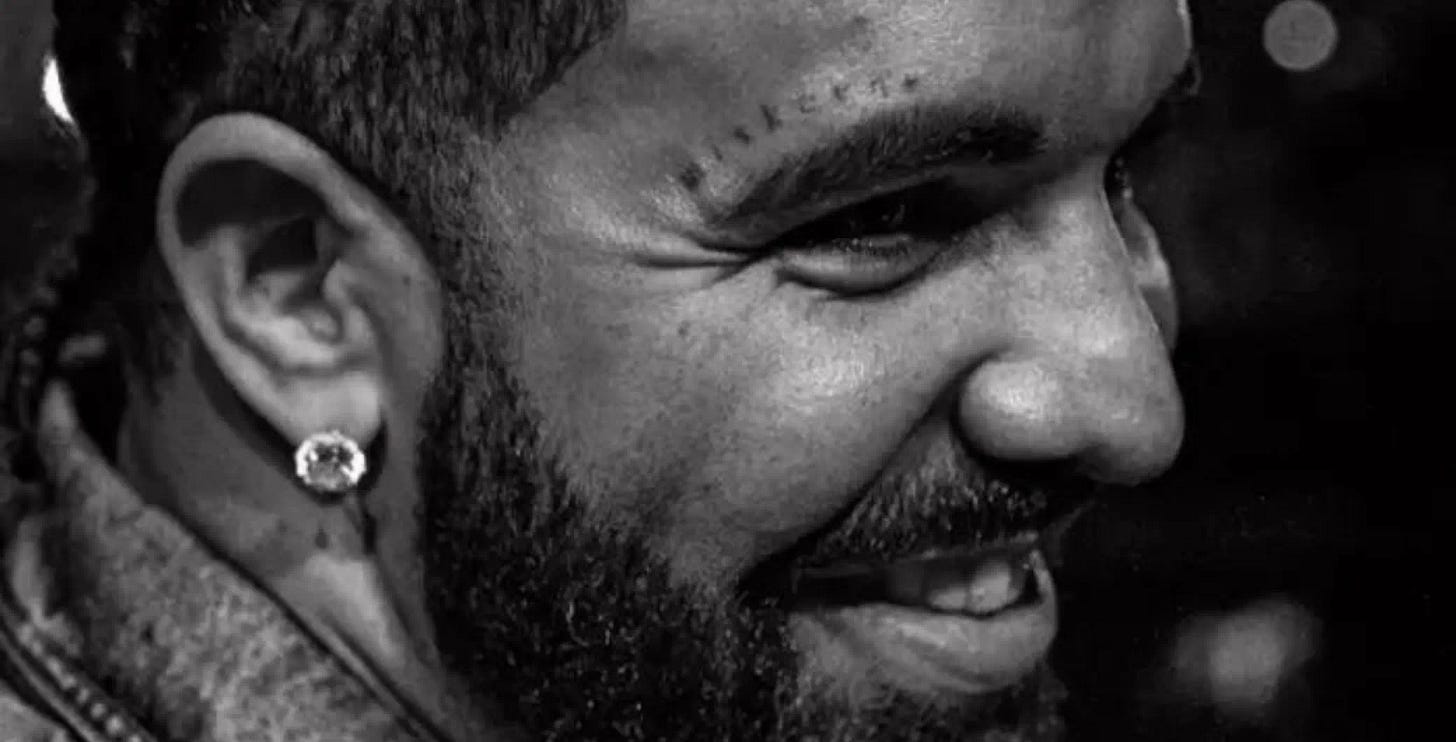Last weekend, I was blessed to attend a three-day spiritual gathering entitled The Sacred Arts. Hosted by Patristic Nectar Publications out of St. Andrew’s Orthodox (Greek Rite of Antioch) Church in Riverside, CA. Hosted by their pastor Fr. Josiah Trenham (1:12:00-1:58:00), M.C. Fr. Jason Covarrubias, Fr. Thomas Hernandez, Fr. Joseph Corrigan, and Protodeacon Elias Khoury. Featuring Fr. Maximos Constas and Jonathan Pageau.
People gathered from far-and-wide, and were mostly Greek Rite Orthodox but I ran into one Copt and a Catholic and a Protestant. Both speakers were great, but Pageau has an unique ability to reach those not ordinarily reached by Orthodox evangelists. A task many more men should emulate as their duty. In the meantime, I will be praying to the Lord of the Harvest, and you should too, that he will send forth laborers into his harvest.
Fr. Maximos, to my Afroasiatic delight, quoted liberally from the Desert Fathers. He stressed upon us the eminence of music in the writings of Plato and St. Clement of Alexandria (another pre-schism Afroasiatic father). Plato says rhythm and harmony in soul gives one refinement and dignity. Clement says the music of Christianity, the new song, is Christ himself.
Fr. Maximos says the liturgy is central to our identity as Orthodox Christians. We respond in song, in the sections of the liturgy assigned to us. Those of us with musical talent and training should do so vociferously. Those of us without talent, should listen intently. There was a laugh here. And a great story.
He gave up his professorship of Patristics and Orthodox Theology at Harvard Divinity School, the earthly pinnacle of prestige, to be a monk at Simonopetra, Mt. Athos, Greece. This is the way. He has both music talent and training, and so, one day, he lost it when a brother in Christ was from his perspective ruining the beauty of the sacred music the brethren were chanting. He made a formal complaint to his abbot. His abbot told him, “this is not a professional conservatory. You are here to tolerate your brothers, and they are here to tolerate you.” Let us attend.
Fr. Maximos harps on a point I often make here-and-elsewhere, that the pinnacle of praise is to be found in the psalms. He prefers them to be sung in elaborate melodies, but he also told us a story of a debate amongst Desert Fathers, with some reluctant to do anything but monotone reading aloud. Nevertheless, they all agreed in saying the psalms continuously, till kingdom come.
He tells us that St. Basil the Great dedicated at least 14 homilies to the psalms, and that Pythagorus believed that drunken revelers (Galatians 5:21) could be settled down (Galatians 5:23) by certain changes in the mode of music. It is hard, but not impossible, to have beef with someone else whilst continuously chanting the psalms. St. John Goldenmouth also encouraged the singing of the psalms, saying, “there is no need for the harp, be yourself a harp.” And that the liturgy is “a sacred bridge, a living ladder of divine ascent.” (Genesis 28:10-end; John 1:51)
This a patristic argument for the mostly a cappella worship of the Orthodox Church (Greek and Afroasiatic). The Greeks, from some areas, are said to have brought to America their pianos and organs. Ethiopians had this at Holy Trinity Cathedral under the auspices of his beatitude Archbishop Melchizedek and his imperial majesty Emperor hayle’silasé, and for some time, but no longer, in Los Angeles, Oakland, Las Vegas, and Seattle. Of course, we also have drums and sistra, and Copts have cymbals and triangles.
St. Gregory of Nazianzus, says heaven and earth should come together as one great cymbal, uniting us with the seraphim, as we chant in unison, holy, holy, holy… Fr. Maximos recommends his writing on poetry to young people who love literature and beauty. Fr. Maximos encourages moms to start their children off with learning the dismissal hymns and other simple liturgical hymns. Fr. Josiah added the polyeleos (many mercies), which is Psalm 135/136 chanted in the Psalmody alongside trinitarian and christological prayers. The sea, earth, and heaven are respectively representative of silence of sea creatures, barking of land animals, and singing of birds. Humans should practice all three, neglecting none.
On icons, Fr. Maximos says going to view icons in a museum is the equivalent of watching animals in a zoo. It’s not the right place and time. The right place and time is the liturgy, in which we don’t focus on the icons themselves, but use them as reminders to focus on the sacred music being sung in unison. In icons, we can see what it cost God to become man, that transience and death are human, and the act of kenosis (self-emptying Christ did for us; Philippians 2) is greater in his incarnation than his crucifixion. In other words, the mystery of God being born as man is greater than God dying. But obviously both are great.
We can see the cave Christ was humbly born in representing Canaanite temple cults’ sacrificial worship. Christ’s birth and death are depicted as closely related, and theotokos has this look of looking forward to the grief she will feel at his death on a cross during his birth. And his flesh (Hebrews 10:20), which is exclusively from her, is represented by the ἱστός (istos; the loom), from whence we get histology. The thread of the fates in Homer’s The Odyssey conceptually enters iconography with her weaving as the Archangel St. Gabriel announces the incarnation to her.
The Ethiopian tradition preserves this tradition as well, in selam lekee (salutations), gospel singer yilma haylu popularly (8 million views on Youtube alone) sings, “ሐርና : ወርቁን : ስታስማማ” “har ina werqun sitasmama” (as she made silk and gold agree) “የገብርኤል : ድምፅ : ተሰምዐ” “ye’gebriél dimts tesema” (Gabriel’s voice became audible).
Jonathan tirelessly delivered three back-to-back-to-back public lectures, with a 5 mins break between lecture two and three, followed by a private podcast recording with Fr. Josiah, to be released at a later date. His lectures were on preaching the gospel through iconography and architecture. He opened with a remark that he came to Orthodoxy in a small parish of twelve faithful, and so was struck by hope to see the large gathering of hundreds at St. Andrew’s. This was his second time visiting in the past year, and he promised, Lordwilling, to come again soon.
Icon is shorthand for holy image. This matches the ge’ez phraseology, ቅድሳት : ሥዕላት qidisat s(h)3lat/siilat. He began his lecture by displaying an icon of St. Anthony the Great (another Alexandrian), and saying the halo was a pagan tool baptized by the Early Church. As it should be. Sometimes halos are there with some figures, and sometimes not. Context matters. And the lack of a halo is not a defrocking of a saint. God forbid. And an icon of the ἀνάστασις (anastasis; standing up; resurrection) with only the bare bones essentials.
Icons are eschatological, in their final form as if judgment day is nigh, and it is. They are not strictly faithful to scripture. Matching Fr. Maximos, he says their proper place is not in isolation, but in the liturgy, or the small church of your christian home. The mysterious icon of the dormition of theotokos even includes bishops, and Christ holding her soul in his hands. A role-reversal whose beginning and end parallel the rising and the setting of the Sun, with the Mother as the East and the Son as the Sun. Icons are intertextual. They play with each other. They have community.
Jonathan says the more you understand one icon, the more you understand others. Fr. Marc Boulos gave me the same advice re: scripture, which has led to reading Galatians over 20 times, and reaping the fruit thereof in other passages. Jonathan wants us to see the influence of heaven coming down to earth, from revelation to reality. To see light penetrating dark spaces. To notice that Christ goes up (ascends) the mountain, then comes down (descends) to meet his disciples on the water he walks upon. This is the context in which they think he’s a ghost. A parallel to his bright white visage during the Transfiguration (Matthew 17:1-9; 2 Peter 1:16-21).
Jonathan impressed upon us the simultaneity of the icon of crucifixion which includes the criminals crucified alongside the Lord Jesus, to his right and to his left, with the final judgment of us all, unbelieving and believing. And he warned us of the dangers present in the interpretation of icons: reduction, over interpretation, tyranny of symbolism, and anything goes. Icons are not simply scripture. Meanings are great, but they have limits. Sometimes a sideshot means a character is a villain, sometimes it doesn’t. And of course, though the rules aren’t written, there are rules. They’re just not usually matters of dogma (even re: God the Father). And they shouldn’t reflect the idiosyncrasy of our desires and our culture.
Jonathan says that whilst it is true that the Early Church were primitively worshiping in homes, to the credit of the lowest church Protestants (Francis Chan in the U.S. and Chinese Christians in China come to mind), as soon as they were legally able to, Christians began worshipping in buildings. There were two main types of church buildings: the basilica and the domed cathedral. The minimalist basilica was constructed in the design of a cross, though that morphed over time, and was horizontally oriented. The more elaborate domed cathedral was rounder and oriented vertically, with a vault acting like the firmament (he made some flat earth jokes and told us to tell you he said so, but maybe he wasn’t joking).
He was once into modern and postmodern art which he summarizes now as fragmented and hyperspecialized to a fault. These artists take one aspect of reality and zoomin on it to the point that any understanding of the totality is lost. In contrast, sacred art is fractal, it contains a pattern of reality repeated within itself.
And I looked, and, behold, a whirlwind came out of the north, a great cloud, and a fire infolding itself and a brightness was about it, and out of the midst thereof as the color of amber, out of the midst of the fire. Also out of the midst thereof came the likeness of four living creatures. And this was their appearance; they had the likeness of a man. And every one had four faces, and every one had four wings. And their feet were straight feet; and the sole of their feet was like the sole of a calf's foot: and they sparkled like the color of burnished brass. And they had the hands of a man under their wings on their four sides; and they four had their faces and their wings. Their wings were joined one to another; they turned not when they went; they went every one straight forward. As for the likeness of their faces, they four had the face of a man, and the face of a lion, on the right side: and they four had the face of an ox on the left side; they four also had the face of an eagle. Thus were their faces: and their wings were stretched upward; two wings of every one were joined one to another, and two covered their bodies. And they went every one straight forward: whither the spirit was to go, they went; and they turned not when they went. As for the likeness of the living creatures, their appearance was like burning coals of fire, and like the appearance of lamps: it went up and down among the living creatures; and the fire was bright, and out of the fire went forth lightning. And the living creatures ran and returned as the appearance of a flash of lightning. Now as I beheld the living creatures, behold one wheel upon the earth by the living creatures, with his four faces. The appearance of the wheels and their work was like unto the color of a beryl: and they four had one likeness: and their appearance and their work was as it were a wheel in the middle of a wheel. (Ezekiel 1:4-16 KJV).
Of course Jonathan would mention Ezekiel, Topaz, and the four incorporeal beasts aka ethereal living creatures aka cherubim. I named my son after this Major Prophet, and own his scroll’s commentary by Fr. Paul Nadim Tarazi and aleqa keedane’weld kiflé. Topaz is my birthstone. I founded a spiritual fellowship in the name of the four beasts. Coincidence? Or Providence? The latter.
Scripture shows the beasts and the wheels repeating patterns of reality. Sacred architecture is like this, but not exactly. It points us toward the totality and the whole, whether wittingly or unwittingly; shoutout to the Spirit. The Son of Man is enthroned in heaven with earth as his footstool. The four glories (beasts) mirror the four evangelists: Matthew, Mark, Luke, and John. Heaven joins earth everywhere with fractal manifestations of God filling the world with his glory.
Christ, the Son of Man and the Son of God, is Isaiah’s and Matthew’s stone which the builder refused. In architecture, the keystone and capstone hold everything else together. Christ holds reality together. And he does this as our judge and advocate, our stumbling stone and cornerstone.
The counterpoint to the great cathedrals are the innumerable saints of the desert. Two suffice as examples of exceptions to the rule. The rule is of course that salvation is in the church, which meets in buildings. Jonathan points us to the hagiographies of two more Egyptian saints: St. Onuphrius and St. Mary. The former regularly received communion from messengers (angels). The latter received communion only once in her life. I would add the criminal on the right side of the Lord Jesus, who never received communion. These three are examples of mercy triumphing over justice, and yet, there is still plenty of room for justice. Quoting St. Efrem the Syrian, he says, if Adam didn’t take the forbidden fruit, God would have given it to him.
In his homily’s opening remarks on the Sunday of St. Gregory Palamas, Fr. Josiah says that that this Sunday was unjustly stolen from St. Polycarp, direct disciple of the Apostle John who was in turn the direct disciple of Jesus Christ. Though St. Gregory Palamas is great, St. Polycarp is greater. This Sunday matches our ge’ez metsagwi; both gospel readings are on the Paralytic, the one with palsy.
Fr. Josiah quotes St. Elias the Presbyter as saying we should have a rule of prayer that is despotic till it’s erotic. Our prayer routine should be like a hungry man compelled to go to a rich banquet. It should have absolute authority over us. Nearness to Christ should be the goal of prayer and all forms of asceticism, including fasting and almsgiving.
From St. Helena, off the coast of Africa, the second island he was banished to, Napoleon Bonaparte said he was in awe of christian friendship. He mentions many great men who were able to conquer large swaths of territory in their day, and say they amount to nothing. Instead, Christ’s call is heeded across the ages. Fr. Josiah encourages us to sacrifice everything so that we can choose to live in close proximity to our christian friends. This should be our number one priority. And many things will come of it.
Fr. Josiah witnessing my holy matrimony in South Central LA’s EOTC
C.S. Lewis said that it wasn’t until he lost one friend that he realized how each friend brings out a different aspect of us in a unique way. Fr. Josiah tells us christian friendship is a taste of paradise. κοινωνία koinonia (table-fellowship), is sacred. We can accomplish, through the grace of God, so much more together.
To this end, the congregation closed the conference with a heart-wrenching and haunting memory eternal spiritual song for the anniversary of the falling asleep with the Lord of the oldest convert to Orthodoxy in the community, from the 1950s.
My final takeaways from the gathering were found in the bookstore, which we were invited to enter. In it I was pleasantly surprised to find St. Vladimir’s press books from Copt Aba Matthew al-miskeen (the Poor) and Syriac-speaking Syrian St. Jacob of Serugh (born in the year of Chalcedon).
As the Greeks say:
lord have mercy, kyrie eleison (Greek), yara burham (Arabic).
And as we say:
amen (Aramaic), kyrie eleison, igzeeo tesehalene (ge’ez)
P.S.
Wheelchair Jimmy’s latest tattoo is 21st century evidence of a semitic cognate. It is a shoutout to Arabic speakers, of sundry dialects, and ge’ez speakers (north and south of mereb), and his hometown melting pot of Toronto, Canada.






